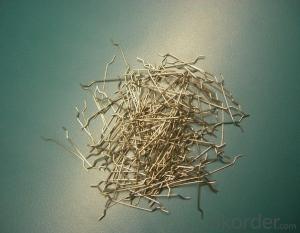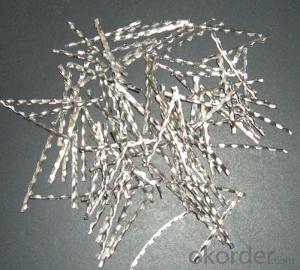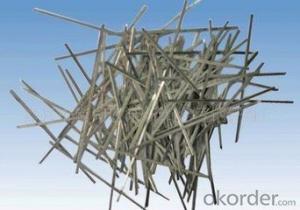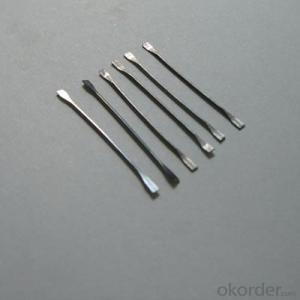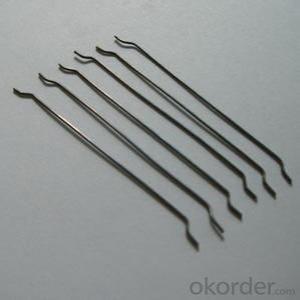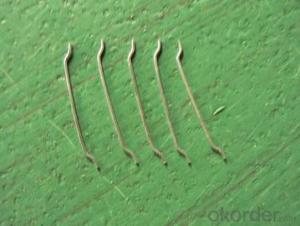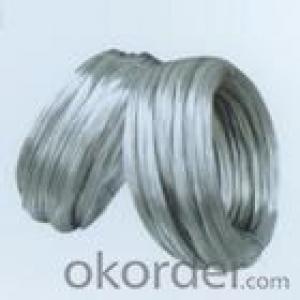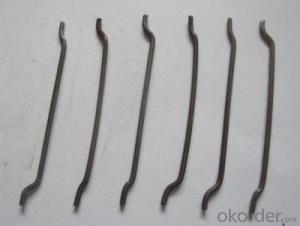Steel Fiber Glued for concrete Tensile strength 1100MPA
- Loading Port:
- Tianjin
- Payment Terms:
- TT OR LC
- Min Order Qty:
- 1000 kg
- Supply Capability:
- 250000 kg/month
OKorder Service Pledge
OKorder Financial Service
You Might Also Like
Quick Details
Place of Origin: Shandong, China (Mainland), Shandong, China (Mainland)
Material: Steel
material: steel wire
shape: corrugated round fiber
appearance: clean and bright
usage: construction and concrete
Model Number: steel fiber
Product features
steel iber for concrete reinforcement ,it`s widely used in buildings ,bridges ,thin roof engineering ,highway etc
cncrete steel iber is specificially designed to enhance concrete in its hardened state ,the uniform distribution of steel fibers throughout the concrete greatly improves concrete bonding and tensile strength ,additionally it provides exceptional load stability and durability ,as reliable and efficient concrete reinforcement material .
it is widely used in buildings ,bridges ,thin roof engineering ,highway etc.
Specifications
Material: round cold drawn wire
Wire diameter: 1.0mm+-0.05mm
Fiber length: 60mm
Fiber diameter: 0.75mm
Tensile strength: ≥1100Mpa
Elongation at break: < 4%
Appearance:bright and clean wire
Package and storage
20KG or 25kg/damp-proof poly and paper composite bag. 50 bags or 40 bags/pallet.
The pallets should be protected against rain and snow.
Product standard
EN14889-1type1(cold drawn wire)
SATM A820/A820M-04type1(cold drawn wire)
Features and benefits(comparing with common concrete)
Tensile Strength (%) | Against pressure (%) | Against shear (%) | against bending (%) | Against impact (%) | Against fatigue (%) | Wear resistance(%) |
50-70 | 8-10 | 50-100 | 120-180 | 200-700 | 50-60 | 25-35 |
Picture



steel fiber for concrete reinforcement
FAQ
we can produce any type steel fiber and of course we can make production according to your requirement
we have specilize in this field for almost 10 years ,with good quality and competitive price
cncrete steel iber is specificially designed to enhance concrete in its hardened state ,the uniform distribution of steel fibers throughout the concrete greatly improves concrete bonding and tensile strength ,additionally it provides exceptional load stability and durability ,as reliable and efficient concrete reinforcement material .
- Q:Is melt extract stainless steel fiber compatible with various types of cement?
- Various types of cement are compatible with melt extract stainless steel fiber. These fibers are specially designed to boost the effectiveness of cement-based materials, such as concrete. They offer reinforcement, enhance durability, improve crack resistance, and strengthen the overall cement matrix. Melt extract stainless steel fibers possess exceptional chemical resistance, enabling them to maintain their integrity and effectiveness even when exposed to different types of cement and aggressive substances. Consequently, whether it's Portland cement, fly ash cement, or any other variety, melt extract stainless steel fibers can effectively enhance their properties and performance.
- Q:What is the effect of melt extract stainless steel fiber on the crack width in concrete?
- The crack width in concrete is significantly affected by the utilization of melt extract stainless steel fibers. These fibers are incorporated into the concrete mixture to enhance its durability and strength. In the event of external forces or temperature fluctuations, cracks may develop. However, the presence of stainless steel fibers aids in controlling and minimizing the width of these cracks. The primary reason behind this impact lies in the distinctive properties of stainless steel fibers. These fibers are recognized for their high tensile strength and ductility. When cracks begin to form in the concrete, the stainless steel fibers serve as reinforcement and distribute the stress throughout the matrix. This redistribution of stress helps prevent the cracks from expanding. Furthermore, the inclusion of stainless steel fibers also enhances the overall toughness of the concrete. Consequently, the concrete becomes more resistant to the propagation of cracks. This implies that even if cracks do occur, they are less likely to propagate and cause significant damage. Furthermore, melt extract stainless steel fibers also enhance the overall durability of the concrete. They function as a protective barrier against corrosion, safeguarding the concrete from the detrimental effects of moisture, chemicals, and other environmental factors. This increases the lifespan of the concrete structure and reduces the frequency of repairs or replacements. To summarize, the utilization of melt extract stainless steel fibers in concrete has a favorable impact on crack width. These fibers reinforce the concrete matrix, distribute stress, and prevent cracks from expanding. Additionally, they enhance the overall toughness and durability of the concrete, making it more resilient to crack propagation and extending its lifespan.
- Q:What is the effect of melt extract stainless steel fiber on the curing time of concrete?
- The inclusion of melt extract stainless steel fiber in concrete can significantly reduce the curing time. The fibers act as reinforcement, enhancing the overall strength and durability of the concrete. Additionally, the steel fibers promote a more efficient hydration process, leading to accelerated curing and a faster hardening of the concrete.
- Q:What is the recommended fiber length for melt extract stainless steel fiber in concrete?
- The recommended fiber length for melt extract stainless steel fiber in concrete typically ranges from 25mm to 50mm. This fiber length is considered optimal for enhancing the mechanical properties and durability of concrete. It helps to improve the tensile strength, flexural strength, and impact resistance of the concrete, making it more resistant to cracking and improving its overall performance. Additionally, this fiber length ensures proper dispersion and distribution within the concrete matrix, leading to a more uniform reinforcement throughout the structure. However, it is important to note that the specific fiber length may vary depending on the specific application and design requirements, so consulting with a structural engineer or following manufacturer guidelines is recommended.
- Q:How does melt extract stainless steel fiber affect the drying shrinkage of concrete?
- Melt extract stainless steel fiber can significantly reduce the drying shrinkage of concrete. The addition of these fibers helps to control the formation of cracks during the drying process by improving the overall tensile strength and ductility of the concrete. This ultimately leads to a reduction in the overall drying shrinkage, resulting in a more durable and crack-resistant concrete structure.
- Q:How does melt extract stainless steel fiber improve the resistance to sulfate attack in concrete?
- Melt extract stainless steel fiber improves the resistance to sulfate attack in concrete through various mechanisms. Firstly, the addition of stainless steel fibers in the concrete mix enhances the overall durability and longevity of the concrete structure, making it less susceptible to sulfate attack. Sulfate attack occurs when sulfate ions from sources such as groundwater, soil, or industrial waste react with the components of concrete, leading to the formation of expansive compounds that can cause cracking and deterioration of the concrete. The stainless steel fibers, being highly corrosion-resistant, act as a physical barrier against the ingress of sulfate ions into the concrete matrix. They create a network throughout the concrete, providing additional reinforcement and preventing the expansion and cracking caused by sulfate attack. Furthermore, the high tensile strength and flexibility of stainless steel fibers improve the overall mechanical properties of the concrete, making it more resistant to the deleterious effects of sulfate attack. The fibers help to distribute stresses more evenly within the concrete, reducing the potential for cracking and damage. Moreover, the presence of stainless steel fibers can also enhance the resistance of concrete to chemical attack. The stainless steel fibers have a high resistance to corrosion, even in harsh environments, which helps to protect the concrete from the corrosive effects of sulfate ions. In summary, melt extract stainless steel fiber improves the resistance to sulfate attack in concrete by acting as a physical barrier, enhancing the mechanical properties, and providing corrosion resistance. These combined effects result in a more durable and long-lasting concrete structure that can withstand the damaging effects of sulfate attack.
- Q:What is the effect of melt extract stainless steel fiber on the plastic settlement of shotcrete?
- The impact of melt extract stainless steel fiber on the plastic settlement of shotcrete cannot be underestimated. The inclusion of these fibers in the shotcrete mixture not only enhances its overall performance but also mitigates the issue of plastic settlement. Shotcrete is widely utilized in construction due to its rapid and efficient application. Nevertheless, it is susceptible to plastic settlement, which occurs when the material sinks or settles before it solidifies. This settlement can lead to undesirable outcomes such as cracks, voids, and weakened strength in the shotcrete. To combat this problem, melt extract stainless steel fibers have been specifically developed. These fibers are incorporated into the shotcrete mix and uniformly disperse throughout the material during the application process. As the shotcrete settles, the stainless steel fibers act as a reinforcement, providing additional support and preventing excessive settlement. The introduction of stainless steel fibers significantly enhances the tensile strength of the shotcrete, thereby augmenting its resistance to cracking and deformation. These fibers establish a three-dimensional network within the material, bolstering its overall structural integrity. Consequently, the plastic settlement of shotcrete is substantially reduced, ensuring that it maintains its form and strength during the setting process. Moreover, melt extract stainless steel fibers also contribute to the durability and longevity of shotcrete. They serve as a preventive measure against the formation of shrinkage cracks and offer added protection against external factors such as temperature fluctuations, moisture, and chemical exposure. To sum up, the incorporation of melt extract stainless steel fibers into shotcrete yields a positive impact on its plastic settlement. These fibers fortify the material, diminish settlement, and enhance its overall performance, durability, and strength.
- Q:How does melt extract stainless steel fiber improve the toughness of fiber-reinforced shotcrete?
- The toughness of fiber-reinforced shotcrete can be greatly improved by the addition of melt extract stainless steel fiber, thanks to its unique properties and characteristics. By adding these stainless steel fibers to shotcrete, the overall performance and durability of the concrete are enhanced, resulting in increased tensile and flexural strength. The primary reason why melt extract stainless steel fiber improves the toughness of fiber-reinforced shotcrete is its ability to resist cracking and control crack propagation. Shotcrete is susceptible to cracking under various stress conditions, such as shrinkage, thermal changes, or external forces. These cracks can weaken the structure and compromise its integrity. However, incorporating stainless steel fibers acts as reinforcement, creating a three-dimensional network within the shotcrete matrix. The steel fibers act as micro-reinforcement, helping to distribute the stress load more evenly throughout the concrete. This redistribution of stress effectively minimizes the formation and propagation of cracks. The fibers also act as bridging elements, preventing cracks from widening and spreading further. This improved crack control significantly enhances the toughness of the shotcrete, making it more resilient to external forces and reducing the risk of failure. Moreover, melt extract stainless steel fibers possess excellent corrosion resistance properties, which is crucial for shotcrete applications in aggressive environments or structures exposed to moisture and chemicals. Unlike other types of fibers, such as carbon or polypropylene, stainless steel fibers do not degrade over time due to corrosion. This ensures the long-term durability and performance of the fiber-reinforced shotcrete, even in challenging conditions. Furthermore, the high aspect ratio and small diameter of melt extract stainless steel fibers result in a high surface area, enabling better bonding with the shotcrete matrix. This improved bond strength between the fibers and the concrete further enhances the toughness and overall mechanical properties of the shotcrete. In conclusion, melt extract stainless steel fiber enhances the toughness of fiber-reinforced shotcrete by controlling crack formation and propagation, improving bond strength, and providing excellent corrosion resistance. These properties make it an ideal choice for reinforcing shotcrete in various construction applications, including tunnels, bridges, slope stabilization, and structural repairs.
- Q:Does melt extract stainless steel fiber affect the electrical conductivity of concrete?
- Yes, melt extract stainless steel fiber does affect the electrical conductivity of concrete. The addition of stainless steel fibers increases the electrical conductivity of concrete due to the conductive nature of stainless steel. This can be advantageous in applications where electrical conductivity is desired, such as in grounding systems or electromagnetic shielding.
- Q:How does melt extract stainless steel fiber contribute to the ductility of concrete?
- There are several ways in which melt extract stainless steel fibers contribute to the ductility of concrete. Firstly, the addition of these fibers in small proportions enhances the overall flexural and tensile strength of the concrete, making it more ductile and capable of withstanding greater loads without cracking. Secondly, the unique properties of stainless steel, such as its high tensile strength and corrosion resistance, make it an ideal material for reinforcing concrete. When added as fibers, stainless steel provides additional reinforcement throughout the concrete, increasing its toughness and ductility. Moreover, the randomly dispersed stainless steel fibers act as micro-crack arresters, preventing cracks from propagating and improving the concrete's behavior after cracking. This means that even if cracks occur, they are less likely to spread and cause catastrophic failure. Additionally, the melt extract stainless steel fibers improve the bond between the concrete and the fibers themselves. This enhanced bond allows for more effective transfer of loads between the fibers and the surrounding concrete, further enhancing the material's ductility. In conclusion, melt extract stainless steel fibers contribute to the ductility of concrete by improving its flexural and tensile strength, enhancing crack resistance, and improving the bond between the fibers and the concrete. As a result, the concrete becomes more durable and resilient, capable of withstanding greater loads and deformation without failure.
1. Manufacturer Overview |
|
|---|---|
| Location | |
| Year Established | |
| Annual Output Value | |
| Main Markets | |
| Company Certifications | |
2. Manufacturer Certificates |
|
|---|---|
| a) Certification Name | |
| Range | |
| Reference | |
| Validity Period | |
3. Manufacturer Capability |
|
|---|---|
| a)Trade Capacity | |
| Nearest Port | |
| Export Percentage | |
| No.of Employees in Trade Department | |
| Language Spoken: | |
| b)Factory Information | |
| Factory Size: | |
| No. of Production Lines | |
| Contract Manufacturing | |
| Product Price Range | |
Send your message to us
Steel Fiber Glued for concrete Tensile strength 1100MPA
- Loading Port:
- Tianjin
- Payment Terms:
- TT OR LC
- Min Order Qty:
- 1000 kg
- Supply Capability:
- 250000 kg/month
OKorder Service Pledge
OKorder Financial Service
Similar products
New products
Hot products
Related keywords
